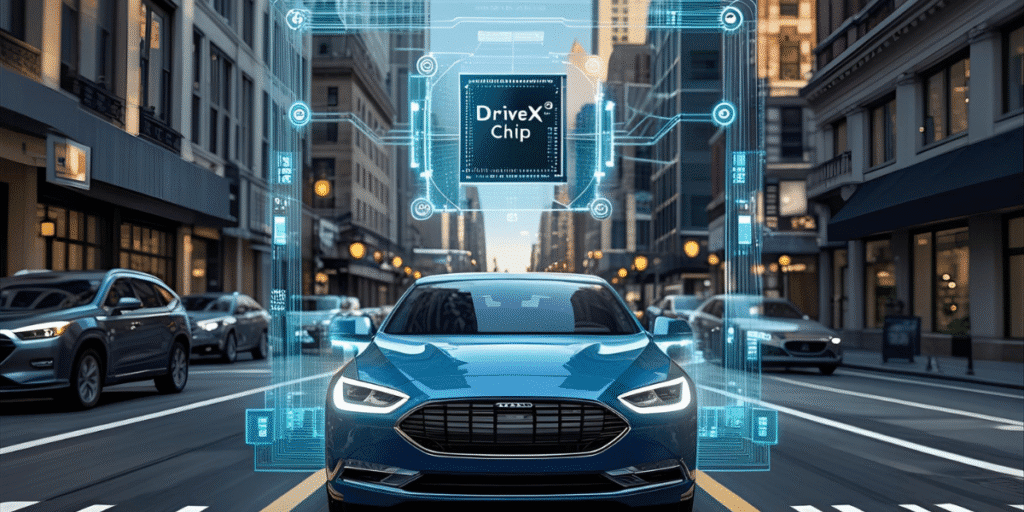NVIDIA has just unveiled a revolutionary advancement in autonomous vehicle technology. Their new AI chip, DriveX, is set to transform the future of self-driving cars, offering unprecedented processing power and efficiency for the complex demands of autonomous driving. With its cutting-edge capabilities, the DriveX chip is poised to become the core brain of autonomous vehicles, making them faster, smarter, and more reliable than ever before.
The Leap in Processing Power
The DriveX chip brings a massive leap in processing capabilities, which is crucial for autonomous vehicles to function safely and effectively. In a self-driving car, real-time data processing from sensors, cameras, and radar is essential for decision-making on the road. The DriveX chip is designed to handle vast amounts of data seamlessly, enabling quicker and more accurate decisions in dynamic driving environments.
One of the standout features of the DriveX chip is its ability to improve object recognition. In autonomous driving, understanding the surrounding environment is key to ensuring safety. With DriveX, vehicles will be able to identify obstacles, pedestrians, and other vehicles with greater accuracy, even in challenging conditions such as low visibility or high-speed driving.
Enhanced Real-Time Decision Making
NVIDIA’s DriveX chip takes real-time decision-making to the next level. For an autonomous vehicle to drive safely, it needs to react to situations as they unfold, like a sudden stop in traffic or an unexpected pedestrian crossing the street. The chip processes input from the vehicle’s sensors faster than ever, ensuring that the car can make split-second decisions.
This responsiveness is critical for avoiding accidents and ensuring that the vehicle adheres to traffic laws while also adapting to unforeseen events. In a future where autonomous driving is common, this ability to process data quickly will be vital for enhancing road safety.
Plug-and-Play Integration with Existing Platforms
NVIDIA is also ensuring that the DriveX chip integrates seamlessly with its existing autonomous driving platform. This means that automakers won’t need to redesign their vehicles or systems to implement the chip—rather, it will be a plug-and-play solution, allowing manufacturers to roll out full self-driving capabilities more easily and efficiently.
By offering an adaptable, modular solution, NVIDIA is lowering the barrier for automakers to bring fully autonomous vehicles to market. This streamlined integration also allows manufacturers to adopt the technology more quickly, helping them stay competitive in the rapidly evolving autonomous vehicle space.
A Major Step Toward Smart Cities
NVIDIA’s ambitions for the DriveX chip extend beyond the car itself. The company is partnering with various transportation firms to develop smart city infrastructure that will support autonomous vehicles. These partnerships aim to create an environment where self-driving cars can operate seamlessly and safely within the broader urban infrastructure.
The integration of autonomous vehicles into city planning represents a shift toward fully automated roadways. These smart cities would use sensors, data analytics, and AI to monitor and optimize traffic flow, road conditions, and safety measures. As a result, self-driving cars equipped with the DriveX chip will be able to interact with their surroundings in a much more dynamic and responsive way.
The Road Ahead for Autonomous Vehicles
NVIDIA’s DriveX chip is a game-changer for the autonomous driving industry. The leap in processing power, real-time decision-making, and ease of integration into existing systems positions NVIDIA as a leading force in the future of self-driving technology. With several major car manufacturers already in talks to adopt the chip, the self-driving revolution is on the horizon.
The broader vision of smart cities with autonomous vehicles on the roads also promises a future where transportation is safer, more efficient, and more interconnected. As NVIDIA continues to push the boundaries of AI and autonomous technology, the DriveX chip could very well be the catalyst that accelerates the widespread adoption of fully autonomous vehicles.
Why It Matters:
The DriveX chip will enable car manufacturers to create self-driving vehicles that are safe, efficient, and reliable. This leap in technology could help accelerate the transition to a future where autonomous vehicles are a common part of everyday life, shaping the way we think about transportation and city planning for years to come.
